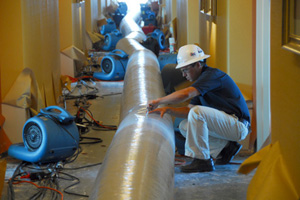Water damage can mean much more than just soggy carpets. For example, mold and mildew grow rapidly in damp, humid environments, creating an unpleasant smell that permeates floors, walls, and ceilings, even after the water has been removed. Mold also can create health problems for employees that can lead to liability issues. It’s not uncommon for employees to take legal action against a company if they become sick from mold particles in the air.
Damage to the building’s structure and foundation is an issue as well. When water sits for a period of time, the walls, ceilings, and floors absorb the water, which threatens the overall structural integrity of the facility. Total reconstruction often becomes the only option.
Another major threat to business is the loss of expensive equipment.
To minimize water damage caused by a frozen pipe burst, two critical steps must be taken. First, act fast to assess the situation, and then control the environment within the building.
Act Fast and Contact a Water Damage Expert

|
| Key to limiting water damage is to quickly control three conditions of a building’s atmosphere: relative humidity, temperature, and air circulation. |
The absolute first step is to act quickly. Damage resulting from water pipe breaks is progressive. The longer the water flows or wet conditions exist, the greater the recovery problem becomes. Once a pipe break occurs, enlist a water damage consultant to immediately survey the situation. Most are able to respond quickly at any time of the day or day of the week.
In a typical pipe burst scenario, a water damage specialist dispatches a team of water damage recovery professionals to the site to perform a thorough inspection and fully determine the extent of the damage. Then, an intense restoration plan is developed that determines which items are worth restoring and which are better replaced.
After a water damage event, it’s not uncommon for a water damage expert to save clients between 30 and 70 percent of the cost needed to replace contents and/or reconstruct a facility, and limit business interruption to less than a week’s time. Without assistance from a water damage consultant, reconstruction efforts can take weeks if not months, causing aggravation and longer business delays.
Controlling the Interior Environment
Another key in limiting water damage is to quickly control three conditions of a building’s atmosphere: relative humidity, temperature, and air circulation. Fast, effective action will generally confine the damage to the area directly affected by the water damage event.
A highly effective way to control these conditions in a high-moisture environment, especially a large facility, is to employ a disaster drying expert who combines air movers with desiccant dehumidifiers.
Disaster drying often eliminates the need to rip out and replace walls, carpet, floor covering, hardwood floors, and the building structure. It also prevents odors and staining caused by mold and mildew — a major problem that can come back to haunt facility owners weeks later in a building that wasn’t sufficiently dried.
Desiccant Dehumidifiers Key
A facility severely water damaged often needs to employ high volume desiccant dehumidifiers. Some larger desiccant dehumidifiers can pull 800 gallons of water out of a building in one day, compared to the typical small refrigeration units that remove about five gallons a day.
Many people are surprised that “solid” materials such as concrete and hard woods absorb moisture. But they do and rather quickly.
Removing water involves a phenomenon called migration. Migration is the tendency for water molecules to move toward a low vapor pressure. Filling a room with very dry air, which has low vapor pressure, causes trapped water to migrate outward and evaporate from the surface by the dry air. As the air in the room fills with water vapor, it is then expelled.
It’s also important the dehumidification equipment is correctly sized for the space. Inappropriately sized drying equipment can lead to insufficient drying and long-term problems.
Best Defense: A Disaster Recovery Plan
Winter water damage via broken water pipes is a common problem and does not discriminate. To minimize damage and costs, companies need to think ahead about what to do in a water damage event and contact a water damage expert to create a disaster recovery plan. A disaster recovery plan can limit the extent of water damage occurrences by defining and prioritizing the recovery of areas within a facility and stating immediate next steps. Proper planning and fast action are most certainly the best defense to preventing a catastrophic water damage event.
Publication date: 02/06/2012


Report Abusive Comment